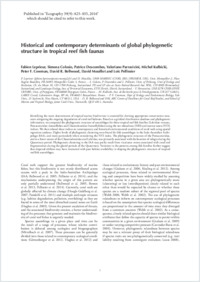Historical and contemporary determinants of global phylogenetic structure in tropical reef fish faunas
- Leprieur, Fabien UMR MARBEC (CNRS, IRD, IFREMER, UM), Univ. Montpellier, France
- Colosio, Simona Univ. of Fribourg, Unit of Ecology and Evolution, Fribourg, Switzerland
- Descombes, Patrice Univ. of Fribourg, Unit of Ecology and Evolution, Fribourg, Switzerland - Swiss Federal Research Inst. WSL, Birmensdorf, Switzerland - Landscape Ecology, Inst. of Terrestrial Ecosystems, ETH Zürich, Switzerland
- Parravicini, Valeriano USR 3278 CNRS-EPHE CRIOBE, Univ. of Perpignan, France
- Kulbicki, Michel Inst. de Recherche pour le Développement, Laboratoire Arago, Banyuls/mer, France
- Cowman, Peter F. Dept of Ecology and Evolutionary Biology, Yale Univ., New Haven, USA
- Bellwood, David R. ARC Centre of Excellence for Coral Reef Studies, and School of Marine and Tropical Biology, James Cook Univ., Townsville, Australia
- Mouillot, David UMR MARBEC (CNRS, IRD, IFREMER, UM), Univ. Montpellier, France - ARC Centre of Excellence for Coral Reef Studies, and School of Marine and Tropical Biology, James Cook Univ., Townsville, Australia
- Pellissier, Loïc Univ. of Fribourg, Unit of Ecology and Evolution, Fribourg, Switzerland - Swiss Federal Research Inst. WSL, Birmensdorf, Switzerland - Landscape Ecology, Inst. of Terrestrial Ecosystems, ETH Zürich, Switzerland
-
01.09.2016
Published in:
- Ecography. - 2016, vol. 39, no. 9, p. 825–835
English
Identifying the main determinants of tropical marine biodiversity is essential for devising appropriate conservation measures mitigating the ongoing degradation of coral reef habitats. Based on a gridded distribution database and phylogenetic information, we compared the phylogenetic structure of assemblages for three tropical reef fish families (Labridae: wrasses, Pomacentridae: damselfishes and Chaetodontidae: butterflyfishes) using the net relatedness (NRI) and nearest taxon (NTI) indices. We then related these indices to contemporary and historical environmental conditions of coral reefs using spatial regression analyses. Higher levels of phylogenetic clustering were found for fish assemblages in the Indo-Australian Archipelago (IAA), and more particularly when considering the NTI index. The phylogenetic structure of the Pomacentridae, and to a lower extent of the Chaeotodontidae and Labridae, was primarily associated with the location of refugia during the Quaternary period. Phylogenetic clustering in the IAA may partly result from vicariance events associated with coral reef fragmentation during the glacial periods of the Quaternary. Variation in the patterns among fish families further suggest that dispersal abilities may have interacted with past habitat availability in shaping the phylogenetic structure of tropical reef fish assemblages.
- Faculty
- Faculté des sciences et de médecine
- Department
- Département de Biologie
- Language
-
- English
- Classification
- Biological sciences
- License
-
License undefined
- Identifiers
-
- RERO DOC 277621
- DOI 10.1111/ecog.01638
- Persistent URL
- https://folia.unifr.ch/unifr/documents/305301
Statistics
Document views: 129
File downloads:
- pdf: 167
